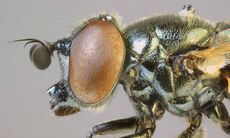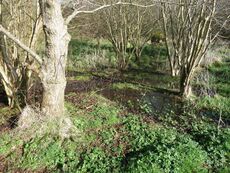Biology:Lejogaster metallina
| Lejogaster metallina | |
|---|---|

| |
| Lejogaster metallina | |
| Scientific classification | |
| Kingdom: | |
| Phylum: | |
| Class: | |
| Order: | |
| Family: | |
| Subfamily: | |
| Tribe: | |
| Genus: | |
| Species: | L. metallina
|
| Binomial name | |
| Lejogaster metallina (Fabricius, 1777)
| |
Lejogaster metallina is a Palearctic species of hoverfly.[1]
Description
External images
For terms see Morphology of Diptera
Shiny metallic green. Antennae completely black. Antennomere 3 round. Legs black. The male genitalia are figured by Maibach, A. & Goeldlin de Tiefenau (1994) .[2] The larva is illustrated by Hartley (1961)[3]
Wing length 4·75-6·5 mm. See references for determination.[4] [5] [6][7]
Distribution
Palearctic Fennoscandia and the Faroes South to Iberia and the Mediterranean basin. Ireland eastwards through Europe to the Russian Far East and Siberia to the Pacific. [8][9]
Biology
Habitat: Wetland; mire, fen, marsh, pool and lake edge; along brooks in Quercus ilex forest in southern Europe.[10] Flowers visited include Ranunculaceae, white umbellifers, Cochlearia, Convolvulus, Leontodon, Polygonum, Symphoricarpos and Valeriana.[11] The flight period is May to June and August to September. The larva is aquatic, living among submerged plant roots.
References
- ↑ Stubbs, Alan E.; Falk, Steven J. (1983). British Hoverflies: An Illustrated Identification Guide (2nd (revised) ed.). British Entomological & Natural History Society. p. 273, xvpp. ISBN 0-9502891-3-2.
- ↑ Maibach, A. & Goeldlin de Tiefenau, P. (1994) Limites génériques et caractéristiques taxonomiques de plusieurs genres de la Tribu des Chrysogasterini (Diptera: Syrphidae) III. Descriptions des stades immatures de plusieurs espèces ouest-paléarctiques. Rev.suisse Zool., 101: 369-411.
- ↑ Hartley, J.C. (1961) A taxonomic account of the larvae of some British Syrphidae. Proc.zool.Soc.Lond.,136: 505-573.
- ↑ Van Veen, M. (2004) Hoverflies of Northwest Europe: identification keys to the Syrphidae. 256pp. KNNV Publishing, Utrecht.addendum
- ↑ Van der Goot,V.S. (1981) De zweefvliegen van Noordwest - Europa en Europees Rusland, in het bijzonder van de Benelux. KNNV, Uitgave no.32: 275pp. Amsterdam.
- ↑ Bei-Bienko, G.Y. & Steyskal, G.C. (1988) Keys to the Insects of the European Part of the USSR, Volume V: Diptera and Siphonaptera, Part I. Amerind Publishing Co., New Delhi. ISBN:81-205-0080-6.
- ↑ Coe, R.L. (1953) Diptera: Syrphidae. Handbks.ident.Br.insects, 10(1): 1-98. R.ent.Soc.London. pdf
- ↑ Fauna Europaea
- ↑ Peck, L.V. (1988) Syrphidae. In: Soos, A. & Papp, L. (eds.) Catalogue of Palaearctic Diptera, 8: 11-230. Akad.Kiado, Budapest.
- ↑ Speight, M.C.D. (2011). "Species accounts of European Syrphidae (Diptera)". Syrph the Net, the database of European Syrphidae 65: 285pp. http://www.diptera.info/downloads/StN_Species_Accounts_Glasgow_2011.pdf.
- ↑ de Buck, N. (1990) Bloembezoek en bestuivingsecologie van Zweefvliegen (Diptera, Syrphidae) in het bijzonder voor België. Doc.Trav. IRSNB, no.60, 1-167.
Wikidata ☰ Q2748218 entry



